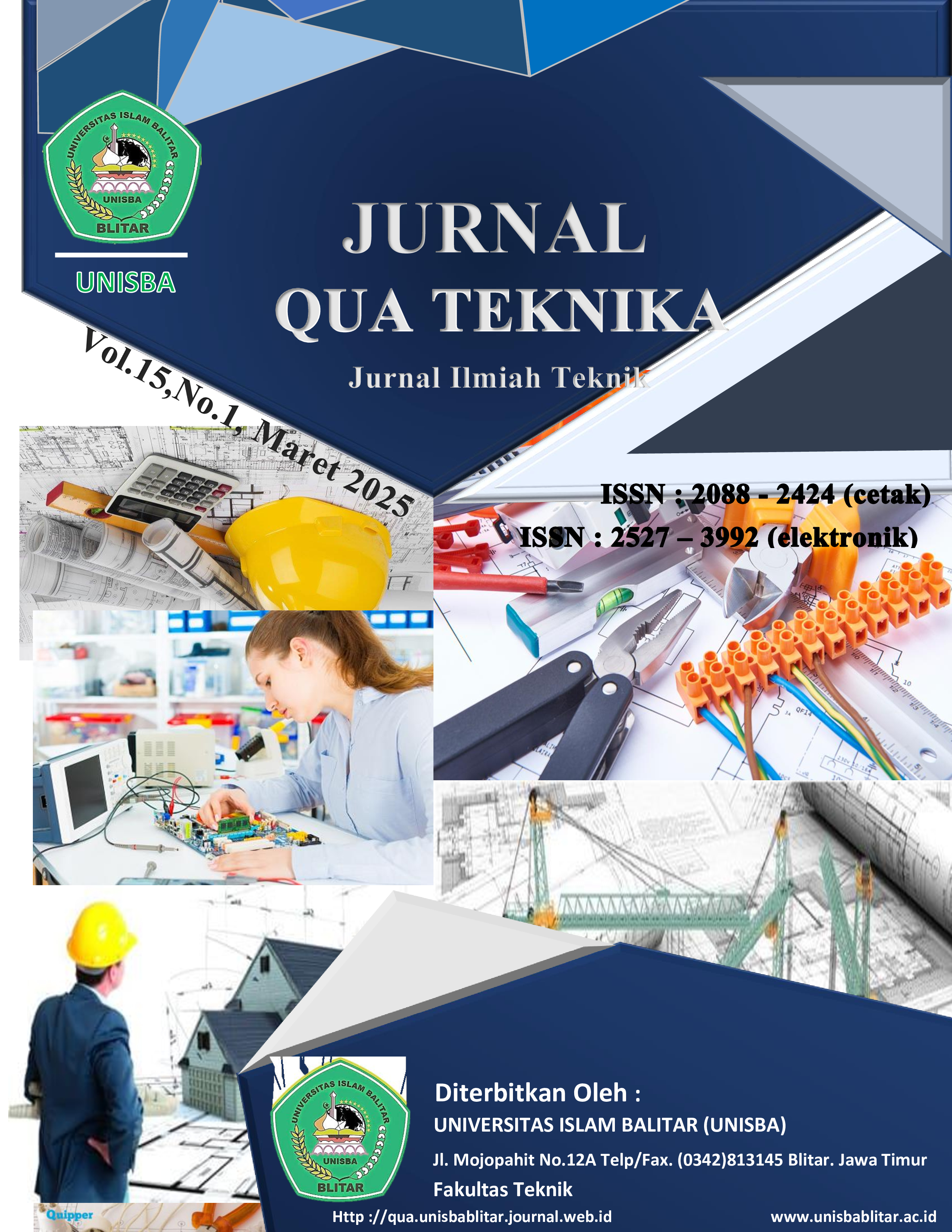MULTILEVEL ENKRIPSI MENGGUNAKAN KOMBINASI ALGORITMA KRIPTOGRAFI BASE64 DAN PEPPER
DOI:
https://doi.org/10.35457/quateknika.v15i01.4364Keywords:
Keamanan, Enkripsi, Kriptografi, Base64, PepperAbstract
Data exchange over the internet is susceptible to security issues. Efforts to secure the system are carried out using various methods. One method used is to encrypt data. This research uses a combination of Base64 and Pepper encryption methods. The Base64 algorithm is a two-way hashing algorithm which is used to encrypt and decrypt data. The Pepper algorithm is used to insert several characters into the data. The combination of the two algorithms uses multilevel techniques. From the test results it can be seen that the application of the combination of the Base64 and Pepper algorithms provides more complex encryption results when compared to the results from the pure Base64 algorithm. because it produces unrecognizable characters.
References
[2] E. Setyawati, C. E. Widjayanti, R. R. Siraiz, and H. Wijoyo, “Pengujian keamanan komputer kriptografi pada surat elektronik berbasis website dengan enkripsi metode MD5,” Jurnal Manajamen Informatika Jayakarta, vol. 1, no. 1, p. 56, Feb. 2021, doi: 10.52362/jmijayakarta.v1i1.367.
[3] S. Nurul, S. Anggrainy, and S. Aprelyani, “Faktor-Faktor Yang Mempengaruhi Keamanan Sistem Informasi: Keamanan Informasi, Teknologi Informasi Dan Network (Literature Review SIM),” Jurnal Ekonomi Manajemen Sistem Informasi, vol. 3, no. 5, pp. 564–573, 2022.
[4] A. Adil Yazdeen, S. R. M. Zeebaree, M. Mohammed Sadeeq, S. F. Kak, O. M. Ahmed, and R. R. Zebari, “FPGA Implementations for Data Encryption and Decryption via Concurrent and Parallel Computation: A Review,” Qubahan Academic Journal, vol. 1, no. 2 SE-Articles, pp. 8–16, Mar. 2021, doi: 10.48161/qaj.v1n2a38.
[5] M. H. Saracevic et al., “Data Encryption for Internet of Things Applications Based on Catalan Objects and Two Combinatorial Structures,” IEEE Transactions on Reliability, vol. 70, no. 2, pp. 819–830, 2021, doi: 10.1109/TR.2020.3010973.
[6] H. Pasaribu, M. F. Harahap, U. P. Indonesia, and S. Seikambing, “Perancangan Aplikasi Hashing File Menggunakan Sha – 224 Berbasis Android,” Jurnal Mantik Penusa, vol. 4, no. 1, pp. 19–26, 2020.
[7] R. Andriyanto, K. Khairijal, and D. Satria, “Penerapan Kriptografi AES Class Untuk Pengamanan URL WEBSITE Dari Serangan SQL INJECTION,” JURNAL UNITEK, vol. 13, no. 1, pp. 34–48, 2020, doi: 10.52072/unitek.v13i1.153.
[8] R. Minarni, “Implementasi Algoritma Base64 untuk Mengamakan SMS pada Smartphone,” Building Informatics, Technology and Science (BITS), vol. 1, no. 1, pp. 28–33, 2019.
[9] Y. Zhang et al., “Information stored in nanoscale: Encoding data in a single DNA strand with Base64,” Nano Today, vol. 33, 2020, doi: 10.1016/j.nantod.2020.100871.
[10] S. Supiyandi, H. Hermansyah, and K. A. P. Sembiring, “Implementasi dan Penggunaan Algoritma Base64 dalam Pengamanan File Video,” JURNAL MEDIA INFORMATIKA BUDIDARMA, vol. 4, no. 2, p. 340, Apr. 2020, doi: 10.30865/mib.v4i2.2042.
[11] A. Kodir and W. Pramusinto, “IMPLEMENTASI KRIPTOGRAFI DENGAN MENGGUNAKAN METODE RC4 DAN BASE64 UNTUK MENGAMANKAN DATABASE SEKOLAH PADA SDN GROGOL UTARA 10,” SKANIKA, vol. 4, no. 1, pp. 7–14, Jan. 2021, doi: 10.36080/skanika.v4i1.884.
[12] A. S. Manullang, R. Puspasari, and W. Verina, “Penyandian Database Menggunakan Metode Base64 Dan Rot13 Database Encoding Using Base64 and ROT13 Methods,” Jurnal FTIK, vol. 1, no. 1, pp. 283–292, 2020.
[13] C. Wadisman, I. Nozomi, and S. Rahmawati, “PENGAMANAN DATABASE MENGGUNAKAN KOMBINASI ALGORITMA (CEST CRYPTOGRAPHY) DAN ALGORiTMA BASE64,” JURTEKSI (Jurnal Teknologi dan Sistem Informasi), vol. 7, no. 1, pp. 33–38, 2020, doi: 10.33330/jurteksi.v7i1.896.
[14] S. W. Jeon, K. S. Kwack, J. S. Yun, S. M. Gho, and S. Park, “Salt-and-pepper noise sign on fat-fraction maps by chemical-shift–encoded MRI: A useful sign to differentiate bone islands from osteoblastic metastases—a preliminary study,” American Journal of Roentgenology, vol. 214, no. 5, pp. 1139–1145, 2020, doi: 10.2214/AJR.19.22177.
[15] P. Bunga, S. Pella, and M. Odja, “Implementasi Secret Sharing Berbasis Kriptografi Visual Skema (k, n) Pada Citra Biner Menggunakan GUI Matlab,” TRANSISTOR Elektro dan Informatika, vol. 5, no. 1, 2023.
Downloads
Published
Issue
Section
License
Copyright (c) 2025 Jurnal Qua Teknika

This work is licensed under a Creative Commons Attribution-ShareAlike 4.0 International License.
Authors who publish with this journal agree to the following terms:
- Copyright on any article is retained by the author(s).
- Author grant the journal, right of first publication with the work simultaneously licensed under a Creative Commons Attribution License that allows others to share the work with an acknowledgement of the work’s authorship and initial publication in this journal.
- Authors are able to enter into separate, additional contractual arrangements for the non-exclusive distribution of the journal’s published version of the work (e.g., post it to an institutional repository or publish it in a book), with an acknowledgement of its initial publication in this journal.
- Authors are permitted and encouraged to post their work online (e.g., in institutional repositories or on their website) prior to and during the submission process, as it can lead to productive exchanges, as well as earlier and greater citation of published work.
- The article and any associated published material is distributed under the Creative Commons Attribution-ShareAlike 4.0 International License
Deprecated: json_decode(): Passing null to parameter #1 ($json) of type string is deprecated in /home/ejournal.unisbablitar.ac.id/public_html/plugins/generic/citations/CitationsPlugin.php on line 68










